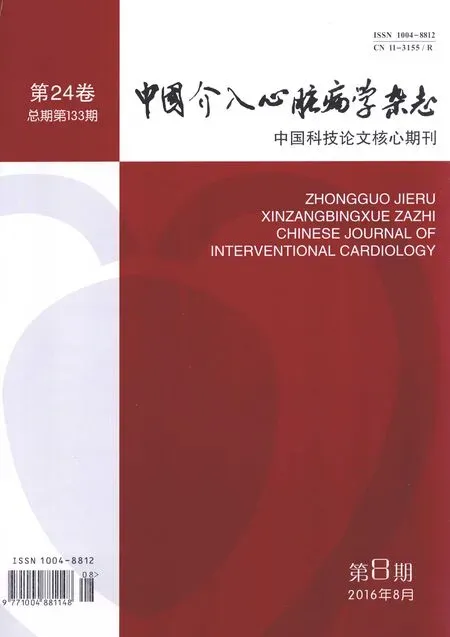冠状动脉造影术与支架置入术对血小板聚集率影响的研究
2016-10-25吴瑛张晓星田蕾蒋娟娟许莉黄一玲刘红李一石
吴瑛 张晓星 田蕾 蒋娟娟 许莉 黄一玲 刘红 李一石
·临床研究·
冠状动脉造影术与支架置入术对血小板聚集率影响的研究
吴瑛张晓星田蕾蒋娟娟许莉黄一玲刘红李一石
目的探讨冠状动脉造影与支架置入术对腺苷二磷酸(ADP)诱导的血小板聚集率的影响。方法前瞻性纳入2012年5月1日至2013年4月30日中国医学科学院阜外医院冠心病患者343例,术前至少7 d连续服用阿司匹林100 mg,每日1次;氯吡格雷75 mg,每日1次。根据支架置入情况分为单纯冠状动脉造影组(造影组,173例)和支架置入组(170例)。患者在接受冠状动脉介入操作之前及之后24 h内,分别采集空腹血样本,用光学比浊法测定血小板聚集率,比较两组患者术前、术后血小板聚集率的变化,支架置入组有66例患者自愿参加血小板聚集率复测亚组分析。结果 两组患者术前、术后血小板聚集率比较,差异无统计学意义(P>0.05);造影组患者术前、术后血小板聚集率比较,差异无统计学意义(P=0.062),而支架置入组患者术后血小板聚集率显著高于术前[(55.59±10.47)%比(52.47±11.97)%,P<0.001],差异有统计学意义;支架置入组患者术后血小板聚集率增加大于造影组[(3.12±8.31)%比(1.06±7.40)%,P=0.010],差异有统计学意义。随着患者支架置入数量的增加,术后血小板聚集率呈递增趋势,但差异无统计学意义(P>0.05)。支架置入组血小板聚集率复测亚组患者(66例)术后30 d血小板聚集率显著低于术后24 h[(54.71±11.64)%比(56.68 ±10.21)%,P=0.019],且与术前基线值比较,差异无统计学意义[(54.71±11.64)%比(54.26± 12.23)%,P=0.901]。结论冠状动脉支架置入操作可导致术后血小板活性升高,该作用可在术后30 d内消失,而单纯冠状动脉造影则无此影响。
冠状动脉造影;支架置入术;血小板聚集
为降低冠状动脉粥样硬化性心脏病(冠心病)患者支架内血栓的发生率,临床工作中逐步开展了以测定个体血小板功能为依据,筛选出血小板高反应性个体,给予在阿司匹林及氯吡格雷常规双联策略基础上的长期强化抗血小板药物治疗[1]。但已发表的研究结果并未显示相应的临床获益[2-3]。冠状动脉介入操作是否可导致一过性血小板活性升高,介入术后血小板功能的测定是否真实反映该个体长期的血小板反应性,这些尚无临床研究证实。为此,有必要开展冠心病患者冠状动脉造影与支架置入操作对血小板聚集率影响的研究,从而为规范围术期抗血小板治疗策略的个体化提供依据。
1 对象与方法
1.1研究对象
纳入2012年5月1日至2013年4月30日在中国医学科学院阜外医院接受冠状动脉造影检查的患者343例,根据血管病变情况行冠状动脉支架置入,并分为单纯冠状动脉造影组(造影组,173例)和冠状动脉支架置入组(支架置入组,170例)。置入支架的适应证由有经验的术者遵循《中国经皮冠状动脉介入治疗指南2012(简本)》[4],判定靶病变是否需要介入治疗。
1.1.1入选标准(1)临床诊断为冠心病,拟接受冠状动脉造影检查,年龄18~85岁。(2)入院前已连续服用阿司匹林100 mg、每日1次,氯吡格雷75 mg、每日1次,连续服用≥7 d。
1.1.2排除标准(1)近14 d内发生急性心肌梗死患者。(2)近14 d内服用质子泵抑制剂患者。(3)术前24 h内及术后应用血小板糖蛋白Ⅱb/Ⅲa抑制药患者。(4)血小板计数小于100×109/L的患者。(5)术前或术后血小板聚集率检测失败患者。(6)伴有其他任何不适合行经皮冠状动脉介入治疗的疾病,包括严重肾功能不全、未控制的心功能不全、碘对比剂过敏等。(7)可能明显改变研究药物吸收、分布、代谢或排泄特征的任何手术或健康状况:近12个月内有活动性炎症性肠病病史,近3个月内发生活动性胃或十二指肠溃疡,谷丙转氨酶(GPT)或谷草转氨酶(GOT)大于2倍正常值上限,肝性脑病病史,食管静脉曲张病史,门静脉分流史。
1.2临床资料收集
收集患者基线资料,包括性别、年龄、体重指数(BMI)、高血压病、2型糖尿病、高脂血症、吸烟史等。实验室检测血常规、凝血分析[(包括凝血酶原时间(PT)、活化部分凝血活酶时间(APTT)]、肝肾功能。
1.3血小板聚集率检测
于患者接受冠状动脉介入操作前及之后的24 h内,分别采集空腹血样本,应用美国Chrono-Log公司560-CA型血小板聚集仪,以光学比浊法(LTA)进行血小板聚集率测定。向富含血小板的血浆中加入5 μl预先配制好的10 μmol/L腺苷二磷酸(ADP),然后放入仪器中进行检测。经ADP激活后,血浆因血小板聚集,以其相对于贫血小板血浆透光度改善的最大值反映血小板聚集的百分比。测量曲线下降的最低点,即最大血小板聚集率。
1.4研究终点
研究主要终点是比较两组患者介入操作后与操作前血小板聚集率的变化幅度;次要终点是比较两种不同的介入操作方法对血小板聚集率的影响。将接受了冠状动脉支架置入的患者中自愿参加术后1个月血小板聚集率复测的患者进行亚组分析,并在该组人群中对复测的血小板聚集率与支架置入术前及术后的测量值进行比较。
1.5统计学分析

2 结果
符合入选标准的888例接受冠状动脉造影检查的患者中,因接受负荷剂量氯吡格雷507例、接受单纯冠状动脉球囊成形术7例、血小板聚集率检测失败7例、术后应用血小板糖蛋白Ⅱb/Ⅲa抑制药9例、未接受冠状动脉介入操作15例,共计545例未纳入本研究。纳入研究的343例患者中,170例(49.6%)因至少有一支冠状动脉主干狭窄大于70%而接受冠状动脉支架置入治疗,平均置入支架(1.89±0.99)枚,其中66例(19.2%)患者术后30 d行血小板聚集率复测;173例(50.4%)仅行冠状动脉造影检查,其中34例(9.9%)因严重冠状动脉病变建议行冠状动脉旁路移植术。2.1两组患者基线资料情况比较
两组患者年龄、性别、BMI、吸烟史、高血压病、血小板计数、血红蛋白浓度、血小板聚集率等比较,差异均无统计学意义(均P>0.05,表1)。

表1 两组患者基线资料情况比较

图1 两组患者术前与术后的血小板聚集率比较
2.2两组患者术后血小板聚集率情况
造影组与支架置入组术后血小板聚集率比较,差异无统计学意义[(54.21±11.44)%比(55.59±10.47)%,P=0.243]。造影组患者术前、术后血小板聚集率比较,差异无统计学意义(P=0.062),而支架置入组患者术后血小板聚集率显著高于术前[(55.59±10.47)%比(52.47±11.97)%,P<0.001],差异有统计学意义(图1)。根据支架置入数量进一步分析显示,随支架置入数量的增加, 术后血小板聚集率呈增加趋势,但差异均无统计学意义(均P>0.05,图2)。支架置入组患者术后血小板聚集率增加大于造影组[(3.12±8.31)%比(1.06±7.40)%,P=0.010],差异有统计学意义。根据血小板聚集率增加的幅度进行分类分析,支架置入组血小板聚集率增幅大于5%的患者比例显著大于造影组(38.8%比24.9%,P=0.005,表2)。

图2 置入不同数量支架患者术后的血小板聚集率比较

血小板聚集率增加值造影组(173例)支架置入组(170例)总患者(343例)P值≤067(38.7)58(34.1)125(36.4)0.3750~5%63(36.4)46(27.1)109(31.8)0.063>5%43(24.9)66(38.8)109(31.8)0.005
2.3术后30 d血小板聚集率复测
支架置入组患者均持续给予氯吡格雷75 mg,每日1次;阿司匹林100 mg,每日1次常规抗血小板治疗。其中66例患者(38.8%)在术后30 d自愿参加血小板聚集率复测的亚组分析。结果显示,在该亚组患者中,冠状动脉支架置入术后24 h内血小板聚集率显著高于术前基线[(56.68±10.21)%比(54.26±12.23)%,P=0.047],术后30 d血小板聚集率显著低于术后24 h[(54.71±11.64)%比(56.68 ±10.21)%,P=0.019],且与术前基线值比较,差异无统计学意义[(54.71±11.64)%比(54.26± 12.23)%,P=0.901]。
3 讨论
本研究通过不同时间对血小板聚集率检测发现,不同冠状动脉介入操作类型对血小板活性的影响存在差异。本研究结果显示,冠状动脉支架置入组患者术后次日血小板聚集率显著高于术前,且亚组分析显示术后次日血小板聚集率亦显著高于术后30 d,差异均有统计学意义;而单纯冠状动脉造影组患者造影术前、造影术次日血小板聚集率比较,差异无统计学意义;与冠状动脉造影组相比,支架置入组患者术后血小板聚集率升高幅度更为显著。该结果考虑与支架置入过程中,冠状动脉血管内皮受到损伤,内皮下胶原暴露,进一步导致血小板激活、黏附、聚集和释放有关[5-7]。
近年研究表明, 人群中存在的氯吡格雷反应性差异表现为ADP诱导的血小板聚集率升高,且与主要不良心脏事件的发生相关[8-9]。指南中亦建议临床医师对特定的患者可以考虑根据血小板聚集率进行个体化治疗[1-2]。但在根据术后血小板功能检测结果调整抗血小板治疗策略的随机分组研究中,仅观察到了剂量调整组中血小板功能的进一步抑制,未观察到临床预后的改善[3,10]。结合本研究结果考虑,可能是由于冠状动脉支架置入操作导致术后一过性升高的血小板活性未能真实体现个体对氯吡格雷的长期反应性。因此错误地给予患者长时间高强度的抗血小板治疗,不仅不能改善患者预后,反而可能增加出血风险及额外的经济负担[11]。
本研究分析显示,随着置入支架数量的增加,患者术后血小板聚集率呈上升趋势,但差异并无统计学意义。这可能与血小板聚集率增幅低、患者样本量小有关。有研究发现,支架置入术后24 h血小板活性显著低于术后即刻[12]。本研究为避免检测结果受饮食因素影响, 在支架置入术后24 h内对患者空腹采血行血小板聚集率检测而非术后即刻, 这也可能是组间差异无统计学意义的另一因素。
氯吡格雷联合阿司匹林双联抗血小板治疗是冠状动脉支架置入术后的标准治疗[13]。早期的国外指南及我国指南对预计接受择期冠状动脉介入治疗操作术前6 h或更早,建议服用负荷剂量氯吡格雷300 mg[4,14-15]。Gurbel等[16-17]研究结果显示,冠心病择期支架置入术前顿服负荷剂量氯吡格雷300 mg对血小板的抑制作用小于75 mg连续每日服用。故而未服用过氯吡格雷的患者在接受300 mg负荷剂量后继续接受75 mg、每日1次维持剂量治疗,其持续下降的血小板聚集率不能准确反映介入操作对血小板聚集率的影响。由此,本研究仅分析术前未接受负荷剂量氯吡格雷且术后连续服用超过7 d的患者不同时间点的血小板聚集率,以期更准确判断介入操作过程对于血小板聚集率的直接影响。此外,提示临床医师针对择期支架置入患者,术前采用连续口服氯吡格雷75 mg较顿服300 mg方案对血小板抑制作用更优。
本研究是一项前瞻性观察性研究,由于样本量小及采血分析血小板聚集率的时间点有限,未能观察到置入支架数量与血小板聚集率升高之间的明确联系,亦未根据支架内药物涂层的类型和支架长度进行亚组分析。今后可在更大样本量的人群中根据支架置入数量、炎性因子及Micro-RNA等指标进一步地探索研究,以明确其间的相互联系,为临床治疗策略提供进一步理论依据。
总之,冠状动脉支架置入操作可导致术后血小板活性升高,该作用可在术后30 d内消失,而单纯冠状动脉造影则无此影响。本研究结果提示,基于冠状动脉支架置入术后测定的血小板聚集率作为判断患者对血小板的长期反应性存在一定局限性。需综合考虑患者置入支架数量、围术期及长期抗血小板药物方案的耐受度等,以期最大限度改善冠心病患者预后。
[1] Levine GN, Bates ER, Blankenship JC, et al. 2011 ACCF/AHA/SCAI Guideline for Percutaneous Coronary Intervention: a report of the American College of Cardiology Foundation/American Heart Association Task Force on Practice Guidelines and the Society for Cardiovascular Angiography and Interventions. Circulation,2011,124(23):e574-e651.
[2] Wright RS, Anderson JL, Adams CD, et al. 2011 ACCF/AHA focused update incorporated into the ACC/AHA 2007 Gui·delines for the Management of Patients with Unstable Angina/Non-ST-Elevation Myocardial Infarction: a report of the American College of Cardiology Foundation/American Heart Association Task Force on Practice Guidelines developed in collaboration with the American Academy of Family Physicians, Society for Cardiovascular Angiography and Interventions, and the Society of Thoracic Surgeons. J Am CollCardiol, 2011,57(19):e215-e367.
[3] Price MJ, Berger PB, Teirstein PS, et al. Standard- vs high-dose clopidogrel based on platelet function testing after percutaneous coronary intervention: the GRAVITAS randomized trial. JAMA, 2011,305(11):1097-1105.
[4] 中华医学会心血管病学分会介入心脏病学组,中华心血管病杂志编辑委员会. 中国经皮冠状动脉介入治疗指南 2012(简本). 中华心血管病杂志, 2012,40(4):271-277.
[5] Gawaz M, Neumann FJ, Ott I, et al. Changes in membrane glycoproteins of circulating platelets after coronary stent implantation. Heart, 1996,76(2):166-172.
[6] Jaster M, Schwimmbeck P, Spencker S, et al. Randomized comparison of platelet-leukocyte aggregates and platelet activation in blood: heparin-coated coiled wire stent implantation versus balloon angioplasty in acute myocardial infarction. Thromb Res, 2003,112(5-6):285-289.
[7] Bonello L, Harhouri K, Sabatier F, et al. Level of adenosine diphosphate receptor P2Y12 blockade during percutaneous coronary intervention predicts the extent of endothelial injury, assessed by circulating endothelial cell measurement. J Am Coll Cardiol,2010,56(13):1024-1031.
[8] Sofi F, Marcucci R, Gori AM, et al. Clopidogrel non-responsiveness and risk ofcardiovascular morbidity. An updated meta-analysis. Thromb Haemost, 2010,103(4):841-848.
[9] Gurbel PA, Bliden KP, Hayes KM, et al. The relation of dosing to clopidogrelresponsiveness and the incidence of high post-treatment platelet aggregation in patients undergoing coronary stenting. J Am Coll Cardiol, 2005,45(9):1392-1396.
[10] Collet JP, Cuisset T,Rangé G, et al. Bedside monitoring to adjust antiplatelet therapy for coronary stenting. N Engl J Med, 2012,367(22):2100-2109.
[11] Stone GW, Witzenbichler B, Weisz G, et al. Platelet reactivity and clinical outcomes after coronary artery implantation of drug-eluting stents (ADAPT-DES): a prospective multi-centre registry study. Lancet, 2013,382(9892):614-623.
[12] Siller-Matula JM, Haberl K, Prillinger K, et al. The effect of antiplatelet drugs clopidogrel and aspirin is less immediately after stent implantation. Thromb Res,2009,123(6):874-880.
[13] Yusuf S, Zhao F, Mehta SR, et al. Effects of clopidogrel in addition to aspirin in patients with acute coronary syndromes without ST-segment elevation. N Engl J Med,2001,345(7):494-502.
[14] Silber S, Albertsson P, Avileés FF, et al. Guidelines for percutaneous coronary interventions. The Task Force for Percutaneous Coronary Interventions of the European Society of Cardiology. Eur Heart J, 2005,26(8):804-847.
[15] Smith SC Jr, Feldman TE, Hirshfeld JW Jr, et al. ACC/AHA/SCAI 2005 guideline update for percutaneous coronary intervention: a report of the American College of Cardiology/American Heart Association Task Force on Practice Guidelines (ACC/AHA/SCAI Writing Committee to Update 2001 Guidelines for Percutaneous Coronary Intervention). Circulation, 2006,113(7):e166-e286.
[16] Gurbel PA, Bliden KP, Hiatt BL, et al. Clopidogrel for coronary stenting: response variability, drug resistance, and the effect of pretreatment platelet reactivity. Circulation, 2003, 107(23):2908-2913.
[17] Gurbel PA, Samara WM, Bliden KP, et al. Failure of clopidogrel to reduce platelet reactivity and activation following standard dosing in elective stenting: implications for thrombotic events and restenosis. Platelets,2004,15(2):95-99.
Impact of coronary angiography and stent implantation on platelet aggregation in coronary heart disease patients
WU Ying, ZHANG Xiao-xing, TIAN Lei, JIANG Juan-juan, XU Li, HUANG Yi-ling, LIU Hong, LI Yi-shi.
Key Laboratory of Clinical Trial Research in Cardiovascular Drugs, Ministry of Health, State Key Laboratory of Cardiovascular Disease, Fuwai Hospital, National Center for Cardiovascular Diseases, Chinese Academy of Medical Sciences and Peking Union Medical College, Beijing 100037, China Corresponding author: LIU Hong,Email:lchyl_fuwai@sina.com
ObjectiveTo evaluate the impact of coronary angiography and stent implantation procedure on ADP-induced platelet aggregation (PA) in coronary heart disease (CHD) patients. Methods CHD patients admitted in the Fuwai Hospital who had been treated with clopidogrel (75 mg/day) and aspirin (100 mg/day) for at least 7 consecutive days undergoing elective PCI were prospectively enrolled during May 1st2012 to April 30th2013. Based on whether coronary stent was implanted, all of the enrolled patients were divided into two groups: the coronary angiography (CAG) group and the coronary stent implantation (CSI) group. The differences in PA, measured by ADP induced light transmission aggregation, between the preoperative baseline level and the level at 24 hours after the procedures in both patient groups were determined. ResultsA total of 343 patients receiving coronary intervention were enrolled in this study, including 173 patients in the CAG group and 170 patients in the CSI group. Compared with the preoperative baseline, there was no significant difference in PA after the operation in the CAG group [(54.21±11.44)%vs. (53.15±11.80)%,P=0.062], while a significant postoperative PA increase was observed in the CSI group [(55.59±10.47)%vs. (52.47±11.97)%,P<0.001]. After stents implantation, PA showed an increased trend as the number of stents implanted increased. Compared with the CAG group, the PA increased in the CSI group was significantly greater [(3.12±8.31)%vs. (1.06±7.40)%,P=0.010]. Patients received repetitive PA testing (n=66) 30 days after coronary stent implantation, which is significantly lower than the PA 24 hours after PCI [(54.71±11.64)%vs. (56.68±10.21)%,P=0.019] and comparable with the baseline PA before procedure [(54.71±11.64)%vs. (54.26±12.23)%,P=0.901] in this subgroup. ConclusionsCoronary stent implantation causes a transient increase in ADP-induced PA, then returns to baseline after 30 days which does not happen in coronary angiography procedure alone.
Coronary angiography;Stent implantation;Platelet aggregation
10.3969/j.issn.1004-8812.2016.08.004
“重大新药创制”科技重大专项(2012ZX09303-008-001);2010年国家临床重点专科建设项目(《卫生部重点实验室项目》)
100037北京,卫生部心血管药物临床研究重点实验室中国医学科学院阜外医院心内科北京协和医学院
刘红,Email: lchyl_fuwai@sina.com
R541.4
2016-04-25)
